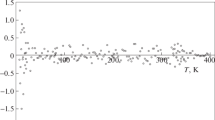Abstract
Water associated with amorphous solids is known to affect significantly the physical and chemical properties of dosage form ingredients. An analysis of water vapor absorption isotherms of poly(vinylpyrrolidone) measured in this and other laboratories, over the range −40 to 60°C, along with the measurement of the glass transition temperature of poly(vinylpyrrolidone) as a function of water content is reported. It is observed that the amount of water vapor absorbed at a particular relative humidity increases with decreasing temperature, along with a significant change in the shape of the isotherm. It is also shown that at any temperature the state of the solid changes from a highly viscous glass to a much less viscous rubber in the region where absorbed water appears to enter into a “solvent-like” state. Further, the apparent “tightly bound” state, observed at low relative humidities, appears to exist when the polymer enters into a very viscous glassy state. It is concluded that the apparent states of water and polymer are interrelated in a dynamic manner and, therefore, that they cannot be uncoupled by simple thermodynamic analyses based only on a water-binding model.
Similar content being viewed by others
REFERENCES
G. Zografi. Drug Dev. Indust. Pharm. 14:1905–1926 (1988).
C. Ahlneck. Some Studies on the Effect of Moisture Sorption on Stability, Compatibility, and Compaction Properties of Drugs and Excipients in the Solid State, Ph.D. thesis, Uppsala University, Uppsala, Sweden, 1988, pp. 28–31.
M. J. Tait, S. Ablett, and F. W. Wood. J. Coll. Interface Sci. 41:594–603 (1972).
F. Khan and N. Pilpel. Power Tech. 50:237–241 (1987).
C. van den Berg. Vapor Sorption Equilibria and Other Water-Starch Interactions: A Physiochemical Approach, Ph.D. thesis, Agricultural University of Wageningen, Wageningen, 1981.
S. Brunauer, P. H. Emmett, and E. Teller. J. Am. Chem. Soc. 60:309–319 (1938).
G. Zografi and M. J. Kontny. Pharm. Res. 3:187–194 (1986).
R. Huettenrauch and J. Jacob. Die Pharm. 32:241–242 (1977).
M. J. Kontny and C. A. Mulski. Int. J. Pharm. 54:79–85 (1989).
R. G. Hollenbeck, G. E. Peck, and D. O. Kildsig. J. Pharm. Sci. 67:1599–1606 (1978).
M. J. Hageman. Drug Dev. Indust. Pharm. 14:2047–2070 (1988).
H. Levine and L. Slade. In F. Franks (ed.), Water Sciences Reviews, Vol. 3, Cambridge University Press, Cambridge, 1987.
A. P. Mackenzie and D. H. Rasmussen. In H. H. G. Jellineck (ed.), Water Structure at the Water-Polymer Interface, Plenum, New York, 1972, pp. 146–172.
H. Nyquist. Int. J. Pharm. Tech. Prod. Mfr. 4:47–48 (1983).
L. Greenspan. J. Res. N.B.S. 81A:89–96 (1977).
P. W. Winston and D. H. Bates. Ecology 41:232–237 (1960).
Y. Y. Tan and G. Challa. Polymer 17:739–740 (1976).
M. Sigiura and E. Fujii. Kogyo Kagaku Zasshi 66:1228–1230 (1963).
M. L. Williams, R. F. Landel, and J. D. Ferry. J. Am. Chem. Soc. 77:3701–3707 (1955).
A. R. Urquart and A. M. Williams. J. Textile Inst. 15:T559–T573 (1924).
H. Batzer and U. Kreibich. Polymer Bull. 5:585–590 (1981).
H. B. Bull. J. Am. Chem. Soc. 66:1499–1507 (1944).
S. R. Kakivaya and C. A. J. Hoeve. Proc. Natl. Acad. Sci. USA 72:3505–3507 (1975).
Author information
Authors and Affiliations
Rights and permissions
About this article
Cite this article
Oksanen, C.A., Zografi, G. The Relationship Between the Glass Transition Temperature and Water Vapor Absorption by Poly(vinylpyrrolidone). Pharm Res 7, 654–657 (1990). https://doi.org/10.1023/A:1015834715152
Issue Date:
DOI: https://doi.org/10.1023/A:1015834715152



